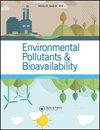保定市城市街道粉尘中砷的生物有效性及形态特征
Q3 Chemical Engineering
引用次数: 17
摘要
摘要从保定市城区采集21份道路扬尘样品,对其中砷的种类及生物利用度进行了调查。采用生物有效性因子(BF)、污染因子(Cf)和地质累积指数模型(Igeo)三个模型对砷的生态风险和生物利用度进行了评价。采用优化的BCR顺序萃取法对粉尘样品中砷的种类进行了分析。街道灰尘样本中砷的总浓度范围为13.16 mg kg−1至67.26 mg kg−1。砷的地质累积指数(Igeo)在0.28-1.99之间。形态分析表明,街道尘样品中As主要存在于残留组分(F4)中,其比例在84.35%至87.07%之间。此外,BF和Cf的范围分别为0.650–0.129和0.119–0.186。结果表明,街道扬尘样品中砷的生物利用度较低。本文章由计算机程序翻译,如有差异,请以英文原文为准。
Bioavailability and speciation of arsenic in urban street dusts from Baoding city, China
Abstract Twenty-one street dust samples were collected from the urban sites in Baoding, China, to investigate the species and bioavailabilty of arsenic in them. The ecological risk and bioavailability of arsenic were evaluated using three models including Bioavailability Factor (BF), Contamination Factors (Cf)and Geoaccumulation Index model (Igeo). The species of arsenic in the dust samples were analyzed using an optimized BCR sequential extraction method. The total concentrations of As in the street dust samples ranged from 13.16 mg kg−1 to 67.26 mg kg−1. Geoaccumulation index (Igeo) of As ranged from 0.28 to 1.99. The speciation analysis indicated that As in the street dust samples were mainly in the residual fraction (F4), and the proportion ranged from 84.35% to 87.07%. Moreover, the ranges of the BF and Cf were 0.650–0.129 and 0.119–0.186, respectively. The results indicated that arsenic contained in the street dust samples was with low bioavailability.
求助全文
通过发布文献求助,成功后即可免费获取论文全文。
去求助
来源期刊
CiteScore
1.62
自引率
0.00%
发文量
0
审稿时长
1 months
期刊介绍:
Chemical Speciation & Bioavailability ( CS&B) is a scholarly, peer-reviewed forum for insights on the chemical aspects of occurrence, distribution, transport, transformation, transfer, fate, and effects of substances in the environment and biota, and their impacts on the uptake of the substances by living organisms. Substances of interests include both beneficial and toxic ones, especially nutrients, heavy metals, persistent organic pollutants, and emerging contaminants, such as engineered nanomaterials, as well as pharmaceuticals and personal-care products as pollutants. It is the aim of this Journal to develop an international community of experienced colleagues to promote the research, discussion, review, and spread of information on chemical speciation and bioavailability, which is a topic of interest to researchers in many disciplines, including environmental, chemical, biological, food, medical, toxicology, and health sciences.
Key themes in the scope of the Journal include, but are not limited to, the following “6Ms”:
Methods for speciation analysis and the evaluation of bioavailability, especially the development, validation, and application of novel methods and techniques.
Media that sustain the processes of release, distribution, transformation, and transfer of chemical speciation; of particular interest are emerging contaminants, such as engineered nanomaterials, pharmaceuticals, and personal-care products.
Mobility of substance species in environment and biota, either spatially or temporally.
Matters that influence the chemical speciation and bioavailability, mainly environmentally relevant conditions.
Mechanisms that govern the transport, transformation, transfer, and fate of chemical speciation in the environment, and the biouptake of substances.
Models for the simulation of chemical speciation and bioavailability, and for the prediction of toxicity.
Chemical Speciation & Bioavailability is a fully open access journal. This means all submitted articles will, if accepted, be available for anyone to read, anywhere, at any time. immediately on publication. There are no charges for submission to this journal.

 求助内容:
求助内容: 应助结果提醒方式:
应助结果提醒方式:


